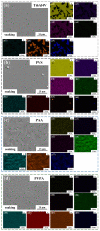Regulation Mechanism of Special Functional Groups Contained in Polymer Molecular Chains on the Tribological Properties of Modified Ti6Al4V
- PMID: 37896304
- PMCID: PMC10609861
- DOI: 10.3390/polym15204060
Regulation Mechanism of Special Functional Groups Contained in Polymer Molecular Chains on the Tribological Properties of Modified Ti6Al4V
Abstract
Polymer coatings can effectively improve the surface tribological properties of human implant materials, thereby increasing their service life. In this study, poly(vinylsulfonic acid, sodium salt) (PVS), poly(acrylic acid) (PAA) and poly(vinylphosphonic acid) (PVPA) were used to modify Ti6Al4V surfaces. Experimental analyses were combined with molecular simulation to explore the regulation mechanism of special functional groups contained in polymer molecular chains on the tribological properties of modified surfaces. In addition, the bearing capacities and velocity dependence of different polymer modified surfaces during friction were also explored. The PVS coating, due to physical adsorption, can have an anti-friction effect under NaCl solution lubrication, but is not durable under long-term or repeated usage. Both PAA and PVPA molecular chains can form chemical bonds with Ti6Al4V. Phosphate acid groups can firmly bind to the substrate, and the adsorption of salt ions and water molecules can form a hydrated layer on the PVPA coating surface, achieving ultra-low friction and wear. The adsorption of salt ions would aggravate the surface wear of the PAA-modified Ti6Al4V due to the unfirm binding of carboxyl groups to the substrate, resulting in a high friction coefficient. This study can provide effective guidance for the design of modified polymer coatings on metals.
Keywords: Ti6Al4V; experimental analyses; functional groups of polymers; molecular simulation; surface modification; tribological properties.
Conflict of interest statement
The authors declare no conflict of interest.
Figures













Similar articles
-
Poly(vinylphosphonic acid) (PVPA) on titanium alloy acting as effective cartilage-like superlubricity coatings.ACS Appl Mater Interfaces. 2014 Oct 22;6(20):17571-8. doi: 10.1021/am503399u. Epub 2014 Oct 3. ACS Appl Mater Interfaces. 2014. PMID: 25244595
-
Multilayers of poly(ethyleneimine)/poly(acrylic acid) coatings on Ti6Al4V acting as lubricated polymer-bearing interface.J Biomed Mater Res B Appl Biomater. 2020 Jul;108(5):2141-2152. doi: 10.1002/jbm.b.34553. Epub 2020 Jan 6. J Biomed Mater Res B Appl Biomater. 2020. PMID: 31904181
-
Regulation Mechanism of Salt Ions for Superlubricity of Hydrophilic Polymer Cross-Linked Networks on Ti6Al4V.Langmuir. 2017 Mar 7;33(9):2133-2140. doi: 10.1021/acs.langmuir.6b04429. Epub 2017 Feb 21. Langmuir. 2017. PMID: 28183180
-
Tribological properties of hydrophilic polymer brushes under wet conditions.Chem Rec. 2010 Aug;10(4):208-16. doi: 10.1002/tcr.201000001. Chem Rec. 2010. PMID: 20533448 Review.
-
Recent Advances in UHMWPE/UHMWPE Nanocomposite/UHMWPE Hybrid Nanocomposite Polymer Coatings for Tribological Applications: A Comprehensive Review.Polymers (Basel). 2021 Feb 18;13(4):608. doi: 10.3390/polym13040608. Polymers (Basel). 2021. PMID: 33670577 Free PMC article. Review.
References
-
- Deng G.Y., Chong Y., Su L.H., Zhan L.H., Wei P.T., Zhao X., Zhang L., Tian Y.Z., Zhu H.T., Tsuji N. Mechanisms of remarkable wear reduction and evolutions of subsurface microstructure and nano-mechanical properties during dry sliding of nano-grained Ti6Al4V alloy: A comparative study. Tribol. Int. 2022;169:107464. doi: 10.1016/j.triboint.2022.107464. - DOI
-
- Cui L.L., Chen J.Y., Yan C.Q., Xiong D.S. Articular Cartilage Inspired the Construction of LTi–DA–PVA Composite Structure with Excellent Surface Wettability and Low Friction Performance. Tribol. Lett. 2021;69:41. doi: 10.1007/s11249-021-01416-y. - DOI
Grants and funding
LinkOut - more resources
Full Text Sources
Research Materials

